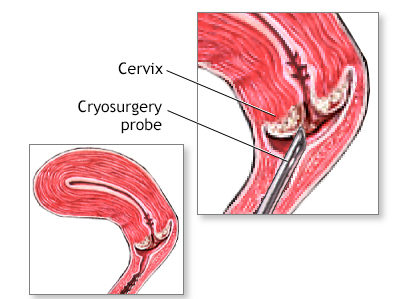Cervical Cryosurgery
Cryosurgery of the cervix uses extremely cold chemicals, like liquid nitrogen, to destroy suspicious cells or tissue in a woman’s cervix. This inch-long tube forms the lower part of the uterus (womb) and connects to the vagina.
Cryosurgery of the cervix is one example of a treatment called cryotherapy. Other names for this treatment include cryoablation and cryosurgical ablation.
Cervical cryotherapy can help women who have:
- Abnormal cells in the cervix that can turn into cancer, such as cervical intraepithelial neoplasia (CIN) and cervical carcinoma in situ (sometimes called stage 0 cancer).
- Irregular bleeding from the cervix.

The procedure takes only a few minutes. While you’re lying on an exam table, the healthcare provider will:
- Insert a metal or plastic tool called a speculum into the vagina to open it, as happens during a Pap test.
- Insert a hollow metal tool called a cryoprobe into the vagina. The probe contains and circulates the chemical (which is as low as –50 degrees Celsius).
- Touch the tip of the cryoprobe to the cells or tissue that need treatment. The tip of the probe will have ice crystals and be cold enough to freeze the tissue.
- Hold the probe in place a few minutes, until the tissue freezes at about –20 degrees Celsius.
- Wait a few minutes, then repeat the ablation if needed.
Advantages of cryosurgery of the cervix?
Cryosurgery is less invasive than other types of surgery, so it involves less pain, bleeding, and risk of other complications. It’s also less expensive and requires less time than other types of surgery.
The procedure doesn’t harm nearby tissues. It can get repeated or combined with other treatments if needed.
